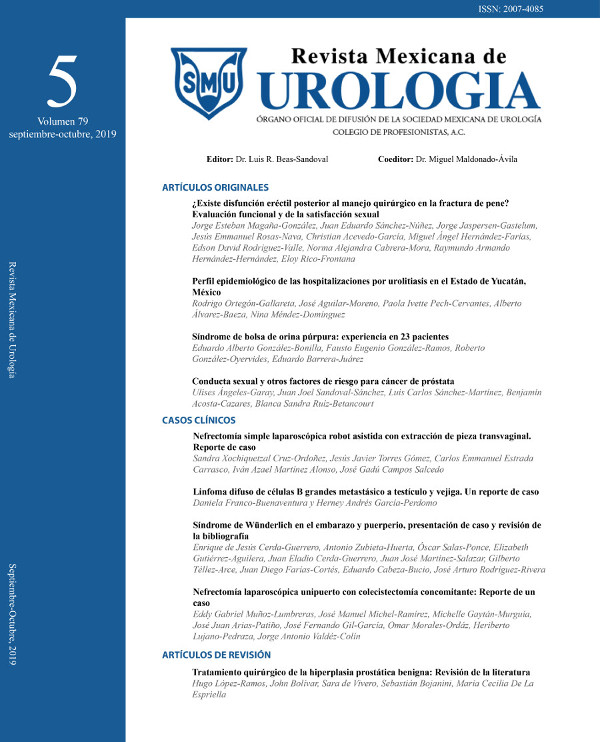Robotic-assisted laparoscopic simple nephrectomy with transvaginal extraction of the surgical specimen: A case report
DOI:
https://doi.org/10.48193/revistamexicanadeurologa.v79i5.460Keywords:
Nephrectomy, Transvaginal, NOTES, Robotic-assisted, LaparoscopicAbstract
Objective: To minimize the morbidity in robotic-assisted laparoscopic nephrectomy by extracting the surgical specimen through a natural orifice, and to standardize said surgical technique with transvaginal extraction, identifying the critical steps and possible complications.
Materials and methods: A woman in the fourth decade of life was multiparous, with a history of recurrent urinary infections secondary to right renal hypoplasia. Right kidney nonfunction was documented through scintigraphy. A traditional surgical technique was proposed. The robotic-assisted laparoscopic transperitoneal approach was performed, with the use of 2 robotic trocars, one abdominal accessory trocar, and one transvaginal accessory trocar.
Results: Two robotic trocars, one accessory trocar at the pouch of Douglas, and one abdominal accessory trocar were utilized. Surgery duration was 45 minutes after robot-patient docking, with blood loss of 30 ml. Hospital stay was 2 days and analgesic use was 5 days. The patient presented with the complication of a urinary tract infection in the late postoperative period that merited antibiotic therapy. There were no other complications.
Conclusion: The robotic-assisted laparoscopic approach, utilizing a natural orifice for surgical specimen extraction, reduces costs, as well as intraoperative and postoperative morbidity, surgery duration, intraoperative blood loss, hospital stay, and analgesic use.
References
Fiorentino RP, Zepeda MA, Goldstein BH, John CR, Rettenmaier MA. Pilot study assessing robotic laparoscopic hysterectomy and patient outcomes. J Minim Invasive Gynecol. 2006;13(1):60–3. doi: https://doi.org/10.1016/j.jmig.2005.11.001
Veljovich DS, Paley PJ, Drescher CW, Everett EN, Shah C, Peters WA. Robotic surgery in gynecologic oncology: program initiation and outcomes after the first year with comparison with laparotomy for endometrial cancer staging. Am J Obstet Gynecol. 2008;198(6):679.e1-9; discussion 679.e9-10. doi: https://doi.org/10.1016/j.ajog.2008.03.032
Sarlos D, Kots L, Stevanovic N, Schaer G. Robotic hysterectomy versus conventional laparoscopic hysterectomy: outcome and cost analyses of a matched case-control study. Eur J Obstet Gynecol Reprod Biol. 2010;150(1):92–6. doi: https://doi.org/10.1016/j.ejogrb.2010.02.012
Lee C-L, Wu K-Y, Su H, Han C-M, Huang C-Y, Yen C-F. Robot-assisted natural orifice transluminal endoscopic surgery for hysterectomy. Taiwanese Journal of Obstetrics and Gynecology. 2015;54(6):761–5. [accessed 3 Sep 2019] Available from: http://www.sciencedirect.com/science/article/pii/S1028455915002375
Alcaraz A, Peri L, Molina A, Goicoechea I, García E, Izquierdo L, et al. Feasibility of Transvaginal NOTES-Assisted Laparoscopic Nephrectomy. European Urology. 2010;57(2):233–7. [accessed 3 Sep 2019] Available from: https://www.europeanurology.com/article/S0302-2838(09)00953-1/abstract
Box GN, Bessler M, Clayman RV. Transvaginal Access: Current Experience and Potential Implications for Urologic Applications. Journal of Endourology. 2009;23(5):753–7. [accessed 3 Sep 2019] Available from: https://www.liebertpub.com/doi/10.1089/end.2009.0150
Pillai R, Yoong W. Posterior colpotomy revisited: a forgotten route for retrieving larger benign ovarian lesions following laparoscopic excision. Arch Gynecol Obstet. 2010;281(4):609–11. [accessed 3 Sep 2019] Available from: https://doi.org/10.1007/s00404-009-1138-5
Allaf ME, Singer A, Shen W, Green I, Womer K, Segev DL, et al. Laparoscopic Live Donor Nephrectomy with Vaginal Extraction: Initial Report. American Journal of Transplantation. 2010;10(6):1473–7. [accessed 3 Sep 2019] Available from: https://onlinelibrary.wiley.com/doi/abs/10.1111/j.1600-6143.2010.03131.x






